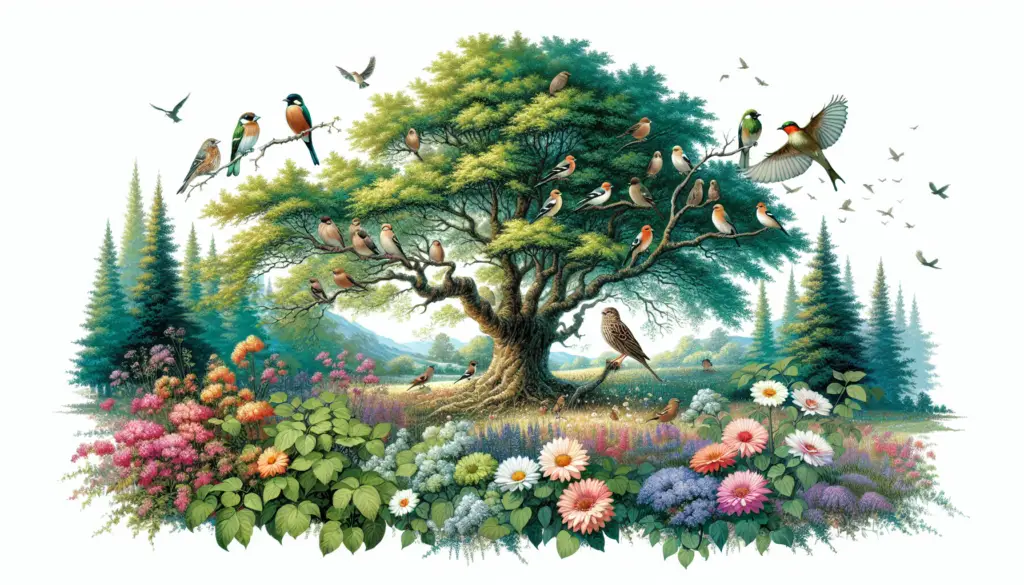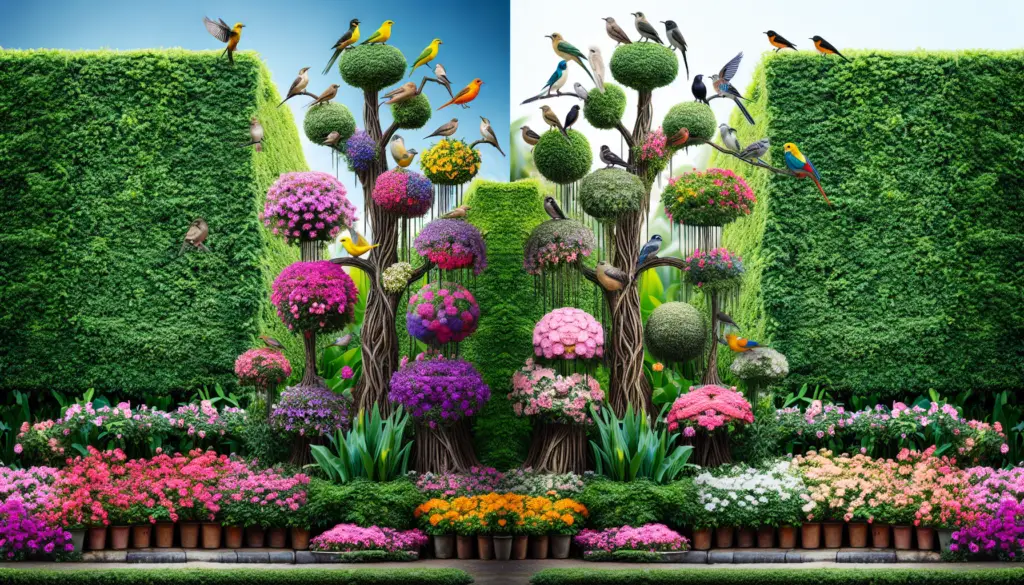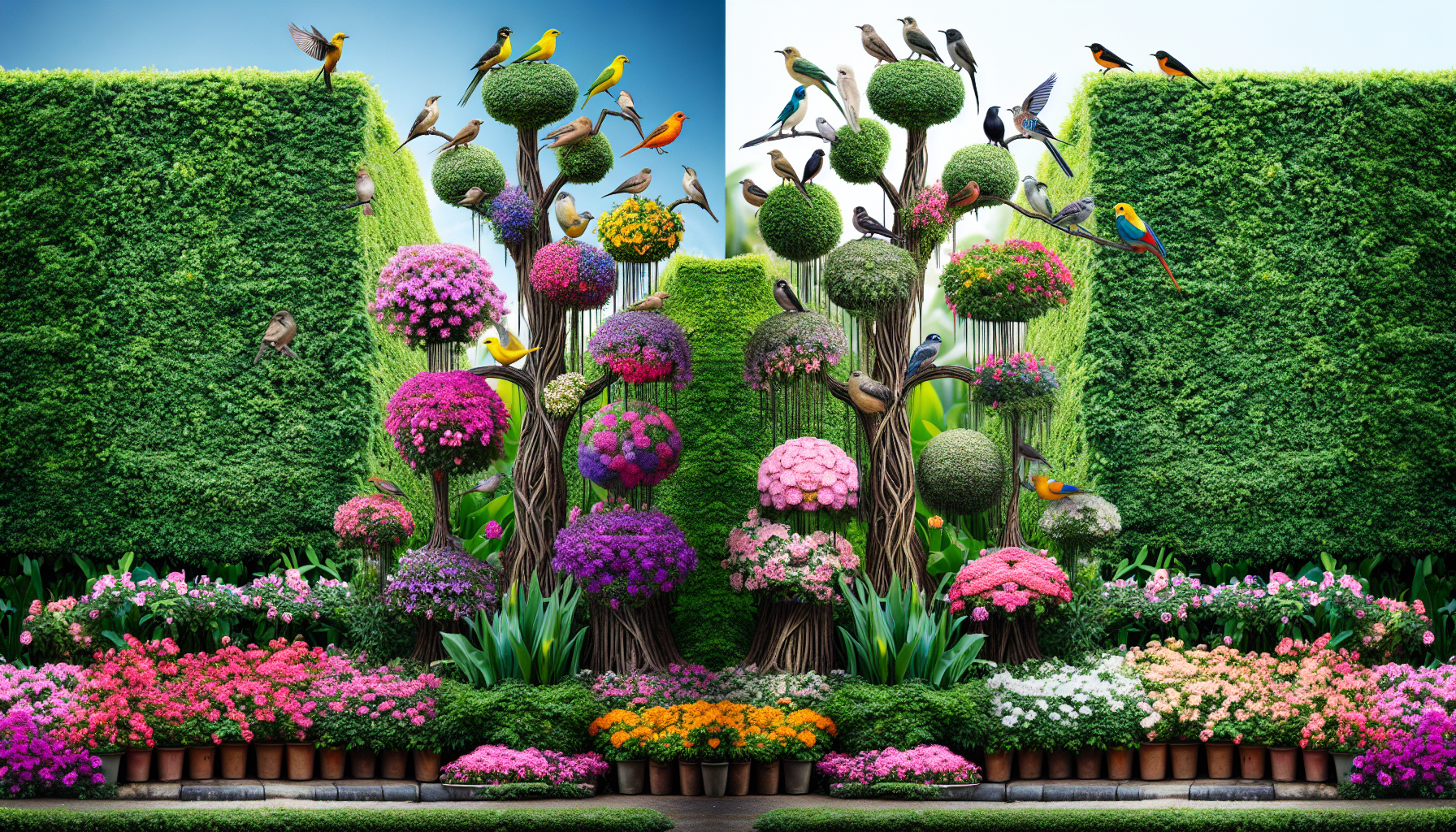Are you longing to invite more feathered friends into your backyard? Look no further! This article holds the key to attracting birds with the perfect flora. Discover the enchanting world of avian visitors and the specific plants and trees that will make them feel right at home. From vibrant flowers to lush greenery, you’ll learn all about the botanical treasures that will make your garden a bird paradise. So get your binoculars ready and prepare to welcome a symphony of wings and delightful melodies!
What Plants And Trees Attract Birds?
If you’re a nature lover and want to attract more birds to your garden, then planting the right plants and trees can make all the difference. Birds are not only beautiful to watch, but they also provide important ecological benefits, such as pollination and insect control. In this article, we will explore different types of plants and trees that can attract a variety of bird species to your outdoor space.

Native Plants
One of the best ways to attract birds to your garden is by planting native plants. Native plants are plants that naturally occur in a specific region and have evolved alongside the local bird species. They provide birds with familiar food sources and shelter, making them extremely attractive to our feathered friends.
Importance of Native Plants
Native plants are crucial for maintaining biodiversity in an ecosystem. By planting native species, you not only support the local bird population but also provide habitat and food sources for other wildlife like pollinators and insects. Native plants have co-evolved with birds, creating a symbiotic relationship that benefits both the plants and the birds.
Native Plants for Different Regions
The specific native plants that attract birds will vary depending on your region. It’s essential to research the native plants in your area to choose the ones that are most likely to attract the birds you want to see. Some common examples of native plants that attract birds include coneflowers, milkweed, sunflowers, and black-eyed Susan.
Berry-Producing Plants
Birds are particularly fond of plants that produce berries. Berries provide birds with a high-energy food source, especially during the winter months when other food options may be scarce. By planting berry-producing plants, you can ensure that your garden becomes a favorite feeding spot for many bird species.
Popular Berry-Producing Plants
There are several popular berry-producing plants that you can consider for your garden. Some examples include elderberry, serviceberry, holly, and dogwood. These plants not only bear delicious fruits for the birds but also add color and beauty to your landscape.
Creating a Berry Garden
To create a berry garden that attracts birds, it’s important to choose a variety of plants with different fruiting times. This will ensure a continuous food supply throughout the year. Additionally, you should consider planting a mix of evergreen and deciduous berry-producing plants to provide both food and shelter for birds.
Flowers and Nectar Plants
Flowers are not only visually appealing but also attract birds with their nectar and bright colors. By planting the right flowers, you can create a haven for hummingbirds, butterflies, and many other bird species.
Flowers that Attract Hummingbirds
To attract hummingbirds, plant flowers that are rich in nectar and have tube-like shapes. Some popular choices include bee balm, trumpet vine, salvia, and cardinal flower. These flowers will not only provide a food source for hummingbirds but also add vibrant colors to your garden.
Butterfly-Attracting Plants
If you want to attract butterflies, there are specific flowers you can plant. Butterflies are attracted to flowers with flat landing surfaces and fragrant nectar. Some examples include butterfly bush, milkweed, lavender, and zinnias. By planting these flowers, you’ll create a beautiful and enticing environment for butterflies to visit.

Trees for Attracting Birds
In addition to plants and flowers, trees play a vital role in attracting birds to your garden. Trees provide birds with nesting sites, shelter, and, in some cases, food sources.
Fruit and Nut Trees
Fruit and nut trees are excellent options for attracting birds. Many bird species are attracted to the fruits and nuts produced by trees such as apple, cherry, mulberry, and oak. These trees not only provide food for birds but also offer shade and a safe place for nesting.
Nesting Trees
Certain trees are highly favored by birds for nesting. These trees have specific features that make them ideal for building nests, such as dense foliage and sturdy branches. Examples of nesting trees include pine trees, oak trees, and willows. By planting these trees in your garden, you provide birds with optimal nesting habitats.
Evergreen Plants
Evergreen plants are plants that retain their foliage year-round, providing birds with a reliable source of shelter and protection. These plants can be an essential addition to your garden as they offer birds a safe haven, especially during harsh weather conditions.
Benefits of Evergreen Plants
Evergreen plants are not only valuable for birds but for your garden as well. They provide privacy, act as windbreaks, and add structure to your landscape. Additionally, evergreen trees and shrubs can buffer noise and provide hiding places for birds to evade predators.
Popular Evergreen Plants
Some popular evergreen plants that attract birds include cedar, fir, pine, and holly. These plants provide birds with cover from predators, nesting sites, and protection from the elements. Introducing evergreen plants into your garden will create an inviting environment for a wide variety of bird species.
Shelter and Roosting Plants
In addition to food sources, birds also need shelter and places to roost. Planting specific types of plants can create natural shelters and nesting spots for birds.
Hedgerows and Thick Foliage
Hedgerows and plants with thick foliage provide excellent shelter for birds. These plants create a dense and protective habitat that birds can use for nesting and roosting. Examples of plants with thick foliage include privet, boxwood, and holly. By planting these types of plants, you provide birds with secure hiding places.
Plants with Dense Branches
Plants with dense branches, such as juniper, arborvitae, and spruce, can also serve as excellent shelters for birds. These plants offer birds protection from the elements and predators, as well as ample spaces for nesting and roosting. By incorporating these plants into your garden, you’ll create a comfortable and safe environment for birds.
Shrubs and Bushes
Shrubs and bushes not only provide food sources but also serve as ideal nesting sites for many bird species. By planting a variety of shrubs and bushes in your garden, you’ll be able to attract a diverse range of bird species.
Attractive Berries and Foliage
Shrubs and bushes with attractive berries and foliage are particularly enticing to birds. Examples include viburnum, chokeberry, sumac, and beautyberry. These plants offer a double benefit by providing birds with both food and shelter. The berries attract birds, while the dense foliage provides nesting sites and hiding places.
Compact Shrubs for Small Spaces
If you have a small garden or limited space, opt for compact shrubs that still provide food and shelter for birds. Some examples of compact shrubs that attract birds include dwarf lilac, potentilla, spirea, and dwarf Alberta spruce. These shrubs are perfect for small spaces, such as patios or balconies, and will still attract various bird species.
Climbing Vines and Trellises
Climbing vines and trellises can be used to create vertical structures that serve as additional shelter and food sources for birds. These structures can provide nesting sites, perches, and even hiding places for birds.
Vines that Provide Shelter and Food
Certain vines are attractive to birds due to their flowers, fruits, or foliage. Examples of vines that can attract birds include honeysuckle, clematis, trumpet vine, and passionflower. By planting these vines and providing trellises for them to climb, you can create a multi-layered environment that birds will love.
Using Trellises to Attract Birds
Trellises can be strategically placed around your garden to entice birds. By growing climbing plants, like morning glories, sweet peas, or climbing roses, on these structures, you’ll provide additional nesting opportunities and food sources for birds. Trellises can also create a visually appealing vertical element in your garden.
Grasses and Seed-Producing Plants
Grasses and seed-producing plants can provide birds with an essential food source. These plants produce seed heads or grasses that many bird species rely on for sustenance.
Suitable Grasses for Birds
Native grasses, such as switchgrass, big bluestem, and Indian grass, provide birds with both food and nesting materials. These grasses produce seed heads that serve as a valuable source of energy for many bird species. By incorporating these grasses into your garden, you create an attractive food source for birds.
Seed-Producing Flowers
Seed-producing flowers can also attract birds to your garden. Examples of seed-producing flowers that birds love include sunflowers, coneflowers, black-eyed Susans, and cosmos. These flowers not only provide nectar for birds but also produce seeds that are highly nutritious. By allowing the flowers to go to seed, you create a natural bird feeding area.
Water Plants and Features
Water is a crucial element for birds, and by incorporating water plants and features into your garden, you can attract a wide variety of bird species. Water sources provide birds with drinking water, a place to bathe, and can even act as natural habitats for specific bird species.
Plants for Ponds and Wetlands
If you have a pond or wetland area, there are specific water plants that can attract birds. Plants like water lilies, cattails, iris, and pickerelweed not only create visual interest in the water but also provide birds with perches, nesting sites, and areas to forage for insects and small fish.
Birdbaths and Water Fountains
Birdbaths and water fountains are excellent additions to any garden wishing to attract birds. Birdbaths provide birds with a reliable source of clean water for drinking and bathing, while water fountains add movement and sound, which can be particularly attractive to birds. By maintaining a clean and fresh water source, you’ll be sure to attract a wide array of bird species.
By incorporating a variety of native plants, berry-producing plants, flowers, trees, evergreen plants, shelter plants, shrubs, climbing vines, grasses, seed-producing plants, and water features into your garden, you can create an inviting haven for birds. Remember, different bird species have different preferences, so diversifying your landscape will attract a greater number of birds. Enjoy the beautiful sights and sounds of a bird-filled garden and contribute to the conservation of these remarkable creatures.

My name is Shane Warren, the author behind Your Bird Buddy – your ultimate guide to the wonderful world of birds! Unleash your inner avian explorer as we delve into a vibrant library of knowledge dedicated to all things feathered. From learning about diverse bird species from across the globe to understanding their captivating habitats and behaviors, I’m here to fuel your passion for these magnificent creatures. Not only that, but I also provide valuable insights on being a responsible and informed pet bird owner. Join our vibrant community and let’s celebrate the feathered wonders of the world together – one chirp at a time. And be sure to join our Your Bird Buddy Community over on Facebook!


Comments are closed